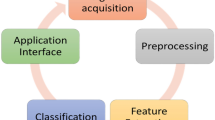Abstract
In this study, we have reinvestigated the chaotic features and sub-band energies of EEG and its ability for aiding neurologists in detecting epileptic seizures. The study was done on the EEG of ictal and interictal phases of epileptic patients and of normal subjects. The EEG was decomposed using discrete wavelet transform to obtain various sub-bands and the chaotic features like correlation dimension and largest Lyapunov exponent were extracted. The analysis results clearly show that the correlation dimension and largest Lyapunov exponent have their lowest value during seizure activity, higher for interictal and even higher values for normal EEG. These values strongly suggest that interictal phase EEG of an epileptic patient is less complex and more predictable compared to normal EEG. Chaotic features extracted are potential parameters for automated diagnosis of epilepsy. Support vector machine (SVM) classifier was implemented based on both sub-band energies and chaotic features extracted from EEG. Classification performance parameters of SVM classifier based on sub-band decomposed energies and chaotic features were calculated.












Similar content being viewed by others
References
Harrison, T. R., & Wilson, J. D. (1991). Harrison’s principles of internal medicine. New York: McGraw-Hill.
Hazarika, N., et al. (1997) Classification of EEG signals using the wavelet transform. In Digital Signal Processing Proceedings, 1997 13th International Conference on (Vol. 1) IEEE.
Chen, D., Wan, S., & Bao, F S. (2015) EEG-based seizure detection using discrete wavelet transform through full-level decomposition. IEEE International Conference on Bioinformatics and Biomedicine.
Adeli, Hojjat, Zhou, Z., & Dadmehr, N. (2003). Analysis of EEG records in an epileptic patient using wavelet transform. Journal of Neuroscience Methods, 123(1), 69–87.
Takens, Floris. (1981). Detecting strange attractors in turbulence. Berlin Heidelberg: Springer.
Natarajan, K., Acharya, R. U., Alias, F., Tiboleng, T., & Puthusserypady, S. K. (2004). Nonlinear analysis of EEG signals at different mental states. BioMedical Engineering OnLine, 3(1), 1.
Grassberger, P., & Procaccia, I. (1983). Characterization of strange attractors. Physical Review Letters, 50, 346.
Claesen, S., & Kitney, R. I. (1994). Estimation of the largest Lyapunov exponent of an RR interval and its use as an indicator of decreased autonomic heart rate control. IEEE Proceedings Computers in Cardiology, 1994, 133–136.
Wolf, A., et al. (1985). Determining Lyapunov exponents from a time series. Physica D, 16(3), 285–317.
Panda, J. R., Khobragade, P. S., Jambhule, P. D., Jengthe, S. N., Pal, P.R., & Gandhi, T. K. (2010) Classification of EEG signal using wavelet transform and support vector machine for epileptic seizure diction. International Conference on Systems in Medicine and Biology, India
Adeli, H., Ghosh-Dastidar, S., & Dadmehr, N. (2007). A wavelet-chaos Methodology for analysis of EEGs and EEG subbands to detect seizure and epilepsy. IEEE Transactions on Biomedical Engineering, 54(2), 205–211.
Acknowledgments
The authors are thankful to the authority of Government Medical College, Thiruvananthapuram, Kerala for giving access to their epileptic EEG database. We are also thankful to the neurologists and EEG technicians for the helpful discussions and for clearing our queries related to this work.
Author information
Authors and Affiliations
Corresponding author
Rights and permissions
About this article
Cite this article
Jacob, J.E., Sreelatha, V.V., Iype, T. et al. Diagnosis of epilepsy from interictal EEGs based on chaotic and wavelet transformation. Analog Integr Circ Sig Process 89, 131–138 (2016). https://doi.org/10.1007/s10470-016-0810-5
Received:
Accepted:
Published:
Issue Date:
DOI: https://doi.org/10.1007/s10470-016-0810-5




